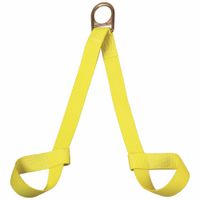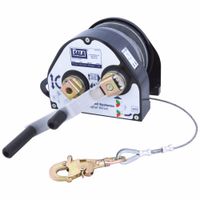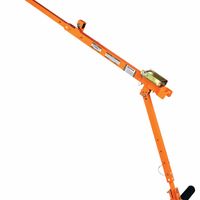Call +(254) 703 030 000 / 751 483 999 / 721 704 777
- Home
- Safety
- Confined Space
- Confined Space Entry Retrieval
.....Read More
Frequently Asked Questions
What is a confined space and why is it hazardous?
A confined space is an area that is substantially enclosed and has limited or restricted means for entry and exit. It is not designed for continuous occupancy. Examples include tanks, silos, storage bins, vaults, and pits. These spaces are often found in industrial settings, construction sites, and even in residential areas like basements or crawl spaces.
Confined spaces are hazardous due to several factors:
1. **Limited Ventilation**: Poor air circulation can lead to the accumulation of toxic gases, vapors, or dust, which can be harmful or fatal. Oxygen levels can also become dangerously low.
2. **Restricted Entry and Exit**: The limited access can make it difficult for workers to enter or exit quickly in case of an emergency, complicating rescue operations.
3. **Physical Hazards**: These spaces may contain moving machinery, electrical hazards, or unstable structures that can cause injury.
4. **Chemical Exposure**: Workers may be exposed to hazardous substances that can cause respiratory issues, skin irritation, or other health problems.
5. **Engulfment Risks**: Loose materials like grain, sand, or liquids can engulf and suffocate a person.
6. **Temperature Extremes**: Confined spaces can have extreme temperatures, leading to heat stress or hypothermia.
7. **Noise and Vibration**: These can be amplified in confined spaces, leading to hearing damage or disorientation.
Due to these hazards, working in confined spaces requires specific safety protocols, including proper training, use of personal protective equipment (PPE), atmospheric testing, and having a rescue plan in place. Employers must ensure that workers are aware of the risks and are adequately prepared to handle emergencies.
What are the key components of a confined space entry system?
The key components of a confined space entry system include:
1. **Permit System**: A documented process that authorizes entry into a confined space, detailing the work to be done, potential hazards, and safety measures. It ensures that all necessary precautions are taken before entry.
2. **Hazard Assessment**: Identification and evaluation of potential hazards such as toxic gases, oxygen deficiency, flammable atmospheres, and physical dangers. This assessment guides the implementation of control measures.
3. **Atmospheric Testing**: Continuous monitoring of the air quality within the confined space to detect hazardous gases, vapors, or insufficient oxygen levels. This is typically done using calibrated gas detectors.
4. **Ventilation**: Use of mechanical ventilation systems to ensure a safe atmosphere by diluting or removing hazardous substances and maintaining adequate oxygen levels.
5. **Personal Protective Equipment (PPE)**: Provision of appropriate PPE such as respirators, helmets, gloves, and protective clothing to protect workers from identified hazards.
6. **Communication System**: Reliable communication methods between workers inside the confined space and those outside to ensure constant contact and coordination.
7. **Entry and Exit Procedures**: Clearly defined procedures for safe entry and exit, including the use of ladders, hoists, or other equipment to facilitate movement.
8. **Emergency and Rescue Plan**: A detailed plan outlining emergency procedures, including the availability of rescue equipment and trained personnel ready to respond to incidents.
9. **Training**: Comprehensive training for all personnel involved in confined space entry, covering hazard recognition, use of equipment, emergency procedures, and permit requirements.
10. **Supervision and Monitoring**: Designation of a competent person to oversee the entry process, ensuring compliance with safety protocols and readiness to respond to emergencies.
These components collectively ensure the safety and health of workers entering and working in confined spaces.
How do davit systems assist in confined space entry and rescue?
Davit systems are crucial for confined space entry and rescue operations due to their design and functionality, which enhance safety and efficiency. These systems consist of a portable or fixed arm (the davit) that can be positioned over a confined space entry point, such as a manhole or tank opening. They provide a secure anchor point for fall protection and rescue equipment, ensuring compliance with safety regulations.
Firstly, davit systems facilitate safe entry by providing a stable and reliable anchor for personal fall arrest systems. Workers entering confined spaces can attach their harnesses to the davit, reducing the risk of falls during entry and exit. This is particularly important in vertical entries where the risk of falling is significant.
Secondly, in rescue scenarios, davit systems enable quick and efficient retrieval of incapacitated workers. The davit arm can be equipped with a winch or retrieval device, allowing rescuers to lift or lower individuals safely. This is essential in emergencies where time is critical, such as when a worker is exposed to hazardous atmospheres or has suffered an injury.
Additionally, davit systems are often portable and adjustable, making them versatile for various confined space configurations. They can be easily transported and set up at different locations, providing flexibility for operations across multiple sites.
Moreover, the use of davit systems minimizes the need for rescuers to enter the confined space, reducing their exposure to potential hazards. This is achieved by allowing external operation of the retrieval system, which is particularly beneficial in toxic or oxygen-deficient environments.
Overall, davit systems enhance the safety and efficiency of confined space entry and rescue by providing secure anchorage, facilitating rapid rescue operations, and minimizing risk to both workers and rescuers.
What is the difference between tripod and pole hoist systems?
Tripod and pole hoist systems are both used for lifting and lowering loads, particularly in confined space operations, but they have distinct differences in design and application.
A tripod system consists of three legs that form a stable triangular base. It is portable and can be quickly set up over a confined space entry point, such as a manhole. The tripod's legs are usually adjustable to accommodate uneven surfaces, and it often includes a pulley system or winch for lifting and lowering. Tripods are ideal for vertical entry and retrieval operations, providing a secure anchor point for fall protection and rescue equipment. They are commonly used in industries like construction, utilities, and emergency services.
In contrast, a pole hoist system typically consists of a single, extendable pole with a hoisting mechanism. It is designed for situations where a tripod cannot be used due to space constraints or when the entry point is not directly below the anchor point. Pole hoists are versatile and can be used for both vertical and horizontal lifting. They are often employed in rescue operations where the entry point is at an angle or when reaching over obstacles. The pole hoist's compact design makes it suitable for tight spaces, but it may require additional stabilization to ensure safety.
In summary, the main differences between tripod and pole hoist systems lie in their structure and application. Tripods offer stability and are best for vertical operations, while pole hoists provide flexibility for angled or horizontal lifting in confined or obstructed spaces.
How do confined space lanyards work in rescue operations?
Confined space lanyards are critical components in rescue operations, designed to ensure the safety of both the rescuer and the individual being rescued. These lanyards are part of a fall protection system, typically used in environments where space is limited, such as tanks, silos, or underground vaults.
The primary function of a confined space lanyard is to prevent falls and facilitate safe retrieval. They are often used in conjunction with harnesses, tripods, and winches. The lanyard connects the harness worn by the worker or victim to an anchor point, which is usually part of a tripod or davit system positioned outside the confined space.
In rescue operations, the lanyard serves several purposes:
1. **Fall Arrest**: If a worker slips or loses balance, the lanyard arrests the fall, minimizing the risk of injury. It is designed to absorb shock, reducing the impact force on the body.
2. **Positioning**: The lanyard helps maintain the worker's position within the confined space, allowing them to perform tasks safely without the risk of falling.
3. **Retrieval**: In an emergency, the lanyard, connected to a winch, enables rescuers to quickly and safely retrieve the worker. The winch allows for controlled lifting or lowering, ensuring the individual is brought to safety without further harm.
4. **Stability**: The lanyard provides stability, preventing the worker from swinging or colliding with the confined space walls during rescue operations.
Confined space lanyards are made from durable materials like polyester or nylon, ensuring strength and reliability. They often include features like shock absorbers and self-retracting lifelines to enhance safety. Proper training and regular equipment inspection are essential to ensure the effectiveness of confined space lanyards in rescue operations.
What are the safety regulations for confined space entry?
Safety regulations for confined space entry are designed to protect workers from hazards associated with working in confined spaces. Key regulations include:
1. **Identification and Assessment**: Employers must identify confined spaces and assess potential hazards, such as toxic gases, oxygen deficiency, and flammable atmospheres.
2. **Permit System**: A permit system is required for entry into permit-required confined spaces. The permit should detail the space, hazards, entry procedures, and emergency plans.
3. **Training**: Workers must receive training on confined space hazards, safe entry procedures, and emergency response. Training should be documented and refreshed regularly.
4. **Atmospheric Testing**: Before entry, the atmosphere must be tested for oxygen levels, flammable gases, and toxic substances. Continuous monitoring may be necessary.
5. **Ventilation**: Adequate ventilation must be provided to ensure a safe atmosphere. This may involve mechanical ventilation to remove hazardous gases.
6. **Personal Protective Equipment (PPE)**: Appropriate PPE, such as respirators, harnesses, and protective clothing, must be provided and used as necessary.
7. **Communication**: Effective communication systems must be in place between workers inside the space and attendants outside.
8. **Attendant**: An attendant must be present outside the confined space to monitor the situation and initiate emergency procedures if needed.
9. **Rescue Plan**: A detailed rescue plan must be in place, with trained personnel and equipment ready for immediate deployment in case of an emergency.
10. **Isolation of Hazards**: All energy sources, such as electrical, mechanical, and hydraulic, must be isolated and locked out to prevent accidental activation.
11. **Signage and Barricades**: Confined spaces should be clearly marked with signs and barricades to prevent unauthorized entry.
These regulations aim to minimize risks and ensure the safety of workers entering confined spaces. Compliance with local and international standards, such as OSHA in the U.S., is essential.
How do confined space winches function in rescue scenarios?
Confined space winches are critical tools in rescue scenarios, designed to safely and efficiently extract individuals from confined spaces such as tanks, silos, or underground vaults. These winches function by providing a controlled means of lifting or lowering personnel or equipment into and out of these restricted areas.
The winch system typically consists of a drum, cable or rope, and a manual or powered mechanism to wind the cable. In rescue operations, the winch is often mounted on a tripod or davit arm, which is positioned over the entry point of the confined space. This setup allows for a stable and secure anchor point, ensuring the safety of both the rescuer and the individual being rescued.
During a rescue, the winch operator controls the ascent or descent of the cable, which is attached to a harness worn by the person being rescued. The winch's braking system is crucial, as it prevents accidental free-fall and allows for precise control over the movement. Some winches are equipped with automatic braking systems that engage if the operator loses control, adding an extra layer of safety.
In addition to manual winches, powered winches are available, which use electric, pneumatic, or hydraulic power to operate. These are particularly useful in scenarios requiring rapid or repeated lifting operations, reducing physical strain on rescuers and increasing efficiency.
Overall, confined space winches are essential for ensuring the safety and success of rescue operations in challenging environments, providing a reliable means of access and egress while minimizing risk to all involved.




